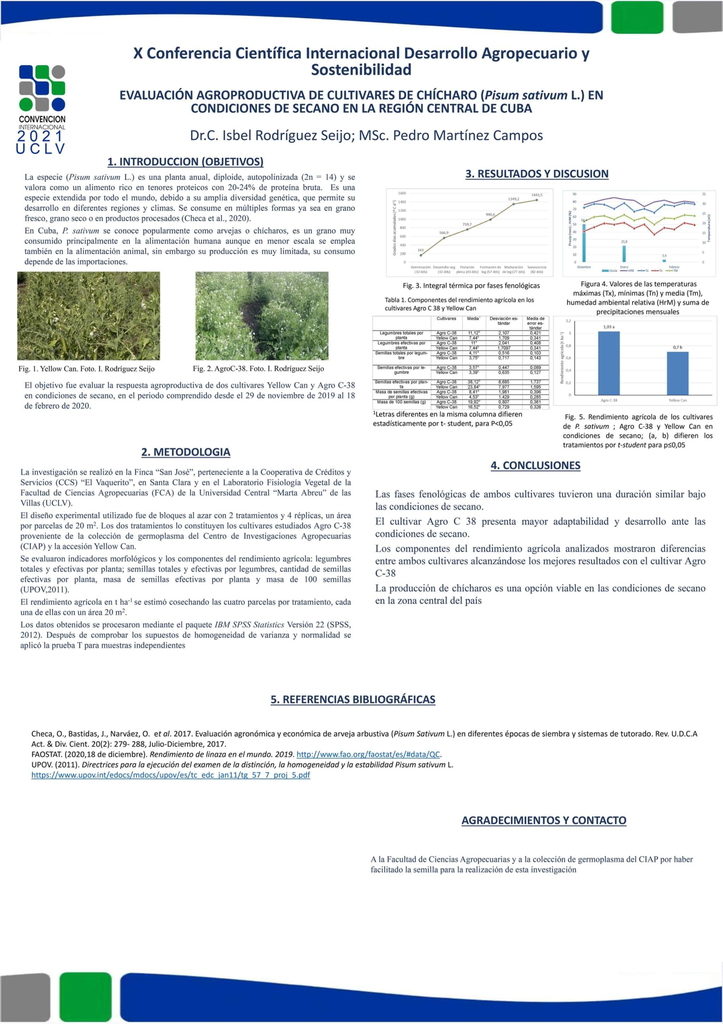Executive Secretary

X Conferencia Científica Internacional sobre Desarrollo Agropecuario y SostenibilidadAGROCENTRO 2023
Agrocentro 2021

Resumen
La seguridad alimentaria es un reto para el sector agropecuario. El chícharo es una especie insuficientemente estudiada en las condiciones edafoclimáticas de Cuba, sin embargo es uno de los granos más utilizados en la alimentación humana. El objetivo del trabajo consistió en evaluar la respuesta agroproductiva de dos cultivares Yellow Can y Agro C-38 en condiciones de secano, en el periodo comprendido desde el 29 de noviembre de 2019 al 18 de febrero de 2020. El diseño experimental utilizado fue de bloques al azar con dos tratamientos y cuatro réplicas. Los dos tratamientos lo constituyen los cultivares Agro C -38 y Yellow Can. Se evaluó la longitud del tallo, número de ramas basales primarias por planta, altura de la primera legumbre, longitud de las legumbres y los componentes del rendimiento agrícola. Durante el ciclo del cultivo se registraron las precipitaciones (mm), la humedad ambiental (%), la evaporación diaria y se registró la temperatura (o C); máxima y mínima diarias para determinar la integral térmica del culti¬vo. Se evaluó el beneficio económico en cada tratamiento. Las diferentes fases fenológicas de ambos cultivares, tuvieron una duración similar bajo las condiciones de secano, el cultivar Agro C-38 presenta mayor adaptabilidad y desarrollo en condiciones de secano; los componentes del rendimiento agrícola analizados mostraron diferencias significativas entre ambos cultivares, alcanzándose mejores resultados en el cultivar Agro C-38 con 1,01 t ha-1, menores gastos variables y mayor beneficio económico. La producción de chícharos es una opción viable en las condiciones de secano.
Abstract
Food security is a challenge for the agricultural sector. The pea is a species insufficiently studied in the edaphoclimatic conditions of Cuba, however it is one of the grains most used in human nutrition. The objective of the work was to evaluate the agroproductive response of two cultivars Yellow Can and Agro C-38 under rainfed conditions, in the period from November 29, 2019 to February 18, 2020. The experimental design used was blocks randomly with two treatments and four replications. The two treatments are made up of the cultivars Agro C -38 and Yellow Can. Stem length, number of primary basal branches per plant, height of the first legume, legume length and components of agricultural yield were evaluated. During the crop cycle, rainfall (mm), environmental humidity (%), daily evaporation were recorded and temperature (o C) was recorded; daily maximum and minimum to determine the thermal integral of the crop. The economic benefit of each treatment was evaluated. The different phenological phases of both cultivars had a similar duration under rainfed conditions, the cultivar Agro C-38 shows greater adaptability and development under rainfed conditions; The components of the agricultural yield analyzed showed significant differences between both cultivars, achieving better results in the cultivar Agro C-38 with 1.01 t ha-1, lower variable costs and greater economic benefit. Pea production is a viable option in rainfed conditions.
Sobre el ponente

Isbel Rodríguez Seijo

Profesor Titular Departamento Agronomía, Facultad de Ciencias Agropecuarias, UCLV.

